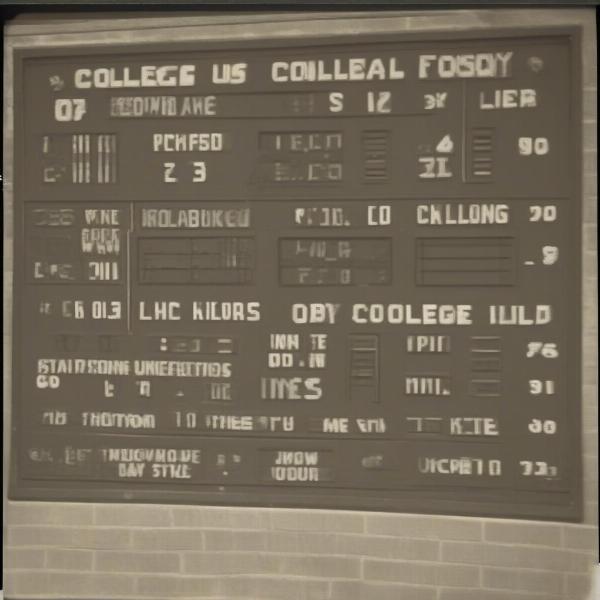The question of whether college football games can end in a tie is a common one among fans, especially those new to the sport or accustomed to the rules of other leagues. At SupremeDuelist.blog, we aim to clarify these points, providing in-depth analysis and easy-to-understand explanations of the intricacies of various games. This article explores the rules concerning ties in college football, explaining why they’re so rare and how overtime procedures work.
This post will delve into the evolution of overtime rules in college football, examining the reasons behind their implementation and the specific format they use today. We’ll also look at the historical context of ties and how they were handled before overtime became standard practice, providing a comprehensive overview of this fascinating aspect of the game.
The Era of Ties in College Football
For many years, ties were a regular occurrence in college football. Games could, and often did, end with both teams having the same score after the allotted time. This was largely due to the absence of a structured overtime system. There was no way to definitively break the deadlock, leaving fans and teams frustrated at times. Before overtime became standard, a tied game was simply the end result and both teams had to accept it.
However, the lack of a resolution to ties became problematic over time, leading to debate and calls for change. This is why the overtime rules were created and became a common thing in College Football. In the past, games might end in a tie, but nowadays it’s something that rarely occurs.
The Introduction of Overtime in College Football
The landscape of college football changed dramatically with the implementation of overtime rules. In 1996, the NCAA introduced a standardized overtime system, aimed at eliminating the possibility of ties. This was a significant shift from the previous practice of accepting ties as a final outcome. The new rules were designed to ensure a clear winner, and significantly enhanced the excitement and engagement for fans and players.
The basic premise of college football overtime revolves around giving each team a chance to score from the same yard line. This system promotes a fair and equal opportunity to break the tie, adding a dramatic element to the game’s conclusion. It also changed the strategy and tactical approach of coaches who now had to work with a specific set of rules and procedures in OT.
How Does College Football Overtime Work?
The current college football overtime system involves a series of alternating possessions. Each team gets a chance to start from their opponent’s 25-yard line and score. If the first team scores a touchdown, the other has a chance to score one as well. If one team doesn’t score, the other team will win in the first round of overtime. If both teams score, the overtime will continue into the next round.
Each team starts with the ball at the 25-yard line and continues until a winner is decided. During the first overtime, teams have to score a touchdown or field goal. From the third overtime onwards, teams have to attempt a 2 point conversion after every touchdown. This format was created to be equal and promote the most excitement. If you’re a fan of college football and love to see this in practice, check out where can i watch alabama game to see your favorite teams battle it out.
 college football overtime procedure
college football overtime procedure
Specific Rules of Overtime
- Starting Point: Each team starts their offensive drive at the opponent’s 25-yard line.
- Scoring: Teams can score via a touchdown, field goal, or safety.
- Initial Overtime Rounds: Teams alternate possessions.
- Subsequent Overtime Rounds: If the score remains tied after the initial rounds, the format may change to require two-point conversion attempts.
- Sudden Victory: The first team to establish a lead after a round where both teams have had a chance to score wins.
- End of Tie Games: The overtime format ensures there is a clear victor and eliminates the possibility of a tie.
Why Are Ties Almost Non-Existent Now?
The implementation of overtime rules is the key reason why ties are now exceedingly rare in college football. The consistent format and alternating possessions guarantee that a winner will emerge. The system is designed to test the mettle of each team in the most equal way possible, leading to exciting and decisive endings.
This change has been a major shift in the way college football is played and viewed. The elimination of ties has made the sport more engaging and satisfying for fans. If you enjoy watching dramatic endings like this, then maybe check out where can i watch the miami hurricane game to see how they handle these intense moments.
Historical Context of Ties in College Football
Before the introduction of overtime, ties were a common and often frustrating part of college football. Many games ended with both teams deadlocked on the scoreboard, leaving a sense of unfinished business. These ties were not always the most appealing for viewers, which made it necessary for a more modern system that could determine a winner.
The evolution of rules in college football demonstrates a constant strive for more excitement and clarity. Before the implementation of overtime, the debate about how to handle ties raged. Many argued that a tied game was anti-climactic and unfair to both teams. Those who enjoy watching old games might have seen these occur and if so, you can check where can i watch old football games to see how they would handle it.
 old football game ending in tie
old football game ending in tie
Impact of Overtime on College Football Strategy
The advent of overtime has dramatically changed how teams prepare and play late in the game. Coaches now need to develop specific offensive and defensive strategies for the pressure-filled overtime setting. Two-point conversion plays become increasingly important, adding another layer of tactical complexity.
The strategic shift has also extended to how teams plan and practice their late-game offense. Coaches often focus on plays that they are confident in running successfully under pressure. The emphasis is on precision and consistency, and the ability to execute when it matters the most.
“The introduction of overtime has not only eliminated ties but also created a more thrilling experience for everyone,” says Dr. Emily Carter, a sports analyst with over 20 years of experience. “Teams now have to prepare for a completely different format, adding a unique challenge to the game.”
Frequently Asked Questions About Ties in College Football
What happens if a college football game is tied after regulation?
If a college football game is tied after regulation, the game proceeds to overtime.
How does overtime work in college football?
Each team gets a chance to score from the opponent’s 25-yard line. If both teams score, overtime continues. From the third overtime onwards, teams must attempt a 2 point conversion.
Have there been changes to the college football overtime rules?
Yes, there have been some minor changes, but the core idea of alternating possessions from the 25-yard line has remained constant. The most recent change was the introduction of the two-point conversion attempts for the third overtime and onward.
Can college football games still end in a tie?
No, with the implementation of the overtime format, it is virtually impossible for a college football game to end in a tie.
What are the implications of the overtime rules on strategy?
Coaches must prepare their teams to play in a high-pressure situation, making specific plays for overtime situations. Two-point conversions become critical after the second overtime, adding a layer of complexity. It’s a whole different game after the regulation, to which both teams have to be accustomed.
 college football overtime win
college football overtime win
Strategic Considerations in Overtime
The strategy in overtime isn’t just about executing plays, it’s also about managing risk. The pressure of the situation means that each decision is incredibly important. Coaches have to balance aggressive play-calling with careful risk assessment. In the third overtime, coaches need to make the decision of going for one or two points after a touchdown. This is a crucial decision that can lead to the end of the game.
The ability to execute a well-planned game plan in the overtime setting is the hallmark of a great team and coaching staff. Players must keep a calm demeanor while performing in this high intensity situation. It’s what can make or break a team, and it can also dictate their record at the end of the season. You can experience all this and more by finding out how can i watch the army navy game and experience how those teams handle these pressure situations.
Conclusion
In summary, while ties were once a reality in college football, the introduction of overtime rules has effectively eliminated them. The modern overtime system guarantees that every game has a definite victor, adding to the excitement and competitive intensity. The alternating possession format, coupled with the two-point conversion requirements from the third overtime, makes college football one of the most engaging and dramatic sports today.
At SupremeDuelist.blog, we are committed to providing our readers with clear and comprehensive analyses of game rules and strategies. Understanding these rules is essential for fully appreciating the drama and skill involved in the game. Explore our other articles for more in-depth coverage of the various aspects of games and entertainment. Be sure to check out other helpful guides that can enhance your experience as a fan.
Leave a Reply